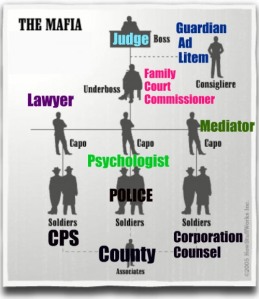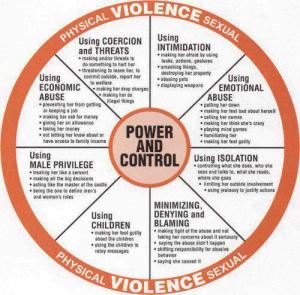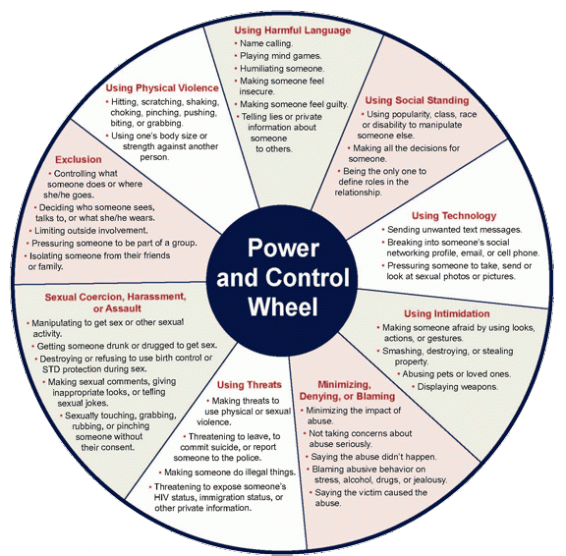I have to share this sad information…. 70% of women in the united states have lost custody of their children to their abuser when they stand up for their children in family court. Out of the 30% of women who maintained some sort of custody 15% of them were granted “Limited Supervised Visitation” because of the accusations of Parental Alienation Syndrome…..
Catch 22 Often Awaits Parents in Child Molest Cases
Special Article, by Anne Hart, Excerpted from The Davis Enterprise, Sunday, October 11, 1998
The term ‘protective parent’ has recently been coined to describe a parent who attempts to protect a child from a violent or incestuous spouse. It appears, at first glance, to be an apt and descriptive phrase. However, it is a misnomer.
The parent who seeks to protect his or her child from abuse often walks innocently into a Catch-22. In fact, some parents liken it to stepping into a bear trap. Imagine yourself a mother in this situation:
- Your child has a series of terrible symptoms. He has nightmares, insomnia, maybe regresses in toilet training and exhibits a host of fears and phobias.
- He becomes dissociative (spaced out) and depressed or out-of-control, even suicidal. You take him to a therapist. He tells you and the therapist he has been sexually abused by his father. He is only 4 years old.
- The therapist makes a mandatory suspected child abuse report. You, the non-offending parent, are interviewed at length by the police. Your child is taken to be interviewed by a team of professionals. Medical examination shows evidence of penetration.
- You are in shock. Your trusted your husband completely. You become exhausted and overwhelmed from trying to cope with your child’s many symptoms, and are unable to sleep from your own fear and anxiety. Nevertheless, you separate from your spouse to protect your child.
- You find an attorney, file for divorce and request full custody. You feel confident that there will be no problem. The Catch-22 begins. You have entered a world you never knew existed.
- Your soon-to-be ex-spouse finds an aggressive attorney who goes on the attack. Every day, a blizzard of incomprehensible paperwork arrives in your mailbox.
- You go to a therapist to cope with your own misery, but your insurance will not pay for the treatment.
- You receive notice that the police have closed the case due to lack of corroboration. The allegations are considered unsubstantiated or unfounded.
- You are called into a series of hearings, in front of a judge who appears bored, irritated or uninterested. Your attorney tries to ameliorate the situation, at the rate of $250 an hour, since he has already spent the $10,000 retainer you gave him.
- A psychological evaluation for the family is ordered, half of which you must pay. Your child begins to have temper tantrums. The nursery school calls to say your child tried to be sexual with another child.
- You bank account begins to decline precipitously.
- Your job is in jeopardy due to taking time off for a seemingly endless series of appointments for testing, mediation and therapy, as well as taking a day off to cry and sleep.
- You take your child to a doctor due to a rash. Evidence of molest is again found. The police interview your child, and again close the case.
- The psychological evaluation comes back, with no mention of the sexual abuse. The report states you are alienating the child from his father. It says you are suffering from an exotic problem such as Munchhausen’s Syndrome by Proxy or Parental Alienation Syndrome and delusions.
- The report states that the only way to save your child from the effects of your alienating behavior is to place him in the custody of the father. Suddenly, you find yourself losing ground rapidly.
- The judge makes a ruling that follows the evaluator’s recommendation. Your child is placed into the full custody of the accused offender. You get to have your child every other weekend from Friday until Sunday.
- You burst into tears, and the judge makes another ruling. Due to your hysterical behavior, you are ordered to have only supervised visits.
- From that point on, everything you do only tightens the noose. The father chooses a new therapist for the child. You have heard the therapist is biased in favor of men, and fear the worst.
- During the visitation, your child whispers that daddy is still doing “nasty” things.
- Your child receives his own court-appointed attorney. The attorney for the minor files a motion to suppress all evidence of molest. The judge agrees, and rules you may not take your child to a doctor.
- Another blizzard of paperwork, motions and hearings occur. Your visitation time is reduced, and you are barred from going to the school.
- Your former husband demands child support from you. He gets it.
- You can no longer afford an attorney, and are forced to represent yourself. You lose your job because you cannot concentrate on sales presentations. You learn that your child is failing in school.
- The judge still refers to the recommendations of the psychological evaluation and maintains the custody arrangements.
- The situation can get worse. You file complaints with the district attorney, the Medical Board, the State Bar and the Commission on Judicial Performance. They receive the complaints.
- You file an appeal, which costs about $30,000. The Court of Appeals decides there is no breach of law, since the judge has broad powers of discretion.
- You approach every agency related to children’s issues you can find. Each official says his hands are tied, and refers you back to the prior agency.
- You go to your legislator. He or she is concerned, but says the branches of government are separate.
- You file for bankruptcy.
- A gag order is placed on you, so you can no longer discuss the case. Your friends begin to avoid you, and no longer return your phone calls.
- The visitation supervisor quits, and now you cannot see your child at all, since the other side will not agree to the supervisors you suggest.
- Your health begins to deteriorate from the ongoing stress.
This scenario sounds impossible. Unfortunately, it is a true story. It is happening in many parts of the United States, including California, as documented in A Mother’s Nightmare, Incest by John E..B. Myers, a professor of law at McGeorge School of Law in Sacramento; The Hostage Child by Michelle Etlin; Divorced from Justice by Karen Winner; and Mothers on Trial by Phyllis Chessler.
These books describe chilling accounts of children being placed in the custody of the accused offender, and cut off from the ‘protective parent’ who loses everything.
The Catch-22 consists of the following:
- You, the non-offending parent, can be charged with felony child endangerment and arrested for not protecting the child, if you do not report to the authorities.
- However, reporting child sexual abuse triggers a series of events that often lead to the child being placed in the custody of the accused offender.
Why is this? The professionals who make the recommendations and judgments have been educated to minimize allegations of incest whenever there is a custody dispute, due to the remote possibility of a false allegation. Therefore, they often miss the real allegations.
The result is that the testimony of the young victim/witness is effectively silenced, and the child is endangered.”
Why are abused children of divorce not protected? Two main reasons are:
MONEY-
Divorce is the outcome of about 50% of marriages in California. In middle and upper-income divorces, child custody has become a huge money-making enterprise.
- Attorneys and mental health professionals make a handsome living from custody litigation. The longer it goes on, the more money they make.
- High-paid judges receive job security, and retired judges “moonlight” by hearing overflow cases.
- In a 1999 Washington Times Insight Magazine article Is Justice for Sale in LA? reporter Kelly O’Meara described other income in the form of payoffs to judges through a slush fund in Los Angeles.
- We need to inform you of a basic fact of court life: Nobody except the very, very wealthy with an ongoing hefty income can afford an attorney throughout a long-term contested custody case. Nobody. It costs way more than you can imagine.
- There are foxes in the hen house, which means that some of the professionals may actively support the abusers for reasons of their own.
LACK OF OVERSIGHT-
No one holds the judges and court appointed professionals accountable for decisions that endanger children.
- Appeals are prohibitively expensive.
- Appeals judges rarely reverse lower court rulings.
- Judges and people they appoint have immunity, which means you can’t sue them.
- The oversight agency Commission for Judicial Performance spends over $3 million dollars per year. In a 3 years period, zero judges were removed from the bench.
“The hottest places in hell are reserved for those who, in times of great moral crisis, maintain their neutrality.” Dante
EXAMPLES
Countless true cases demonstrate the failure of family law courts to protect innocent victims. Read some brief examples of what happens in court, then return back to learn what you can do.
WHAT SHOULD YOU DO?
DON’T PANIC, STAY CALM AND KEEP READING.
Keep CAREFUL RECORDS and a TIME-LINE-
You and your child have just been ambushed. You need several things as you enter into this battle. First, you need to know the tactics of the other side, and be prepared.
For the most part, this is a paper war. You need to keep your documents in order, like keeping your sword sharp for warfare. It’s hard to do, but is very important.
- Get a big three ring binder and plenty of plastic “sleeves” to hold your papers. This way you don’t have to punch holes in the papers, and they don’t get torn.
- Get and keep every single piece of paper that’s generated in your case, including police reports, child protective services reports, evaluations, court transcripts and billing statements from everyone involved.
- Put each document in a separate plastic page holder in order of the dates.
- Make a table of contents by writing a list of everything you put in the binder. That way you can find the documents easily.
- Put a three-hole punch spiral notebook with lined pages in front of your binder. The notebook ensures that you are keeping accurate notes (law enforcement can see that your handwritten dated notes are not compromised). Add more notebooks as you need.
- Put your family law case number, county and judge at the top of the first page.
- Write your ex-spouse’s and your full names, addresses, phones, birth dates, educational levels, occupations, marriage date, separation date, divorce date, and reason for the divorce at the top of the first page.
- Record any changes in addresses or occupations, including the dates.
- Write each of your children’s full names and birth dates.
- Write down the name, phone and address of their therapists, and why the child is seeing a therapist.
- If anyone writes anything incorrect about you or your child, write an immediate polite clarification and send it to the person who wrote the report, to the judge and to all attorneys. Keep a copy.
- Write down every symptom your child has, including dates.
- Always put the full date and quote what your child said as closely as possible.
- If anyone else observed a symptom or a comment from your child, write that down. For example, “Ricky tried to touch his babysitter’s breast on June 10, 1998 and said ‘daddy do that’. The babysitter is Janet X, address, phone.”
- Ask the babysitter, and anyone else who observes abuse, to write a declaration under penalty of perjury. Add them to your binder.
- If someone will write a declaration in support of you, get them to write it immediately. Put it into the binder.
- Every day write details of new developments, such as new disclosures from your child, in the spiral notebook. Always put the full date and quote what your child said as closely as possible.
If your spouse physically attacks you or harasses you by stalking, file a police report and get a temporary restraining order so that he is not allowed to come near you.
Get a copy of the police report and add it to your binder.
Check your court file at the courthouse every few months. Sometimes you will find important papers missing. Write a dated note about the missing document and put it in your binder. Sometimes other people put papers in that you do not know about. Make copies and add a note explaining the date you found the document in your file, and the reason the document is significant.
WARNING: Retribution may occur if you complain!
Although recent appeal cases have limited CPS immunity, they have a great deal of power over you and your child. Proceed with caution. CPS is another example of a Catch 22.
If your child tells a teacher, doctor, clergy, or therapist about child abuse, that person must, by law, report to CPS and/or law enforcement. Here is the Catch 22: You are required by law to protect your child. Yet if your child has parenting time with the identified abuser due to family court orders, CPS may do nothing. (In fact, you may be accused of putting ideas into your child’s mind.)
You can protest the lack of CPS protection of your child. However, remember that you and your child may receive swift retribution for daring to complain or buck the system.
- Read the information about your rights carefully.
- If you wish, make a formal, clear, brief and well-written complaint, and ask for a hearing. Describe specifically what went wrong.
- Always ask someone to edit your complaint, since it is difficult to write clearly when you are upset.
- This is called an administrative remedy. That means you have to try to solve the problem locally first.
- One CPS supervisor advised, “If you plan to complain, go up the chain of command all the way to the director with your complaint as fast as you can, then get a lawyer and sue the agency.”
If you plan to try to have CPS protect your child from the abuser, we advise you to do this in an effective, organized, and precise manner. We have found the following guidelines to be crucial documentation in our cases.
- Begin a careful log in a spiral notebook and record every event, phone call, and letter. Include;
- date and time
- name of the agency and individual you spoke with
- description of the conversation
- direct quotes from the conversations
- result, if any
- Another suggestion is at the bottom of every letter, always write cc: and send copies to these individuals;
- Director of CPS
- Department of Social Services
- County Board of Supervisors
- your attorney
It is not particularly effective to write lots of letters of complaint, since you will probably be ignored. Long letters are often ignored also. However, clear, concise documentation of your reasonable actions is effective. Follow up each meeting with a thank you letter to document a synopsis of the meeting.


